Filled with umami, this easy Japanese Clam Miso Soup will be the newest addition to your soup lineup. The savory kombu broth pairs perfectly with the delicate essence of fresh clam stock. It’s an oceanic culinary experience right in your own bowl.
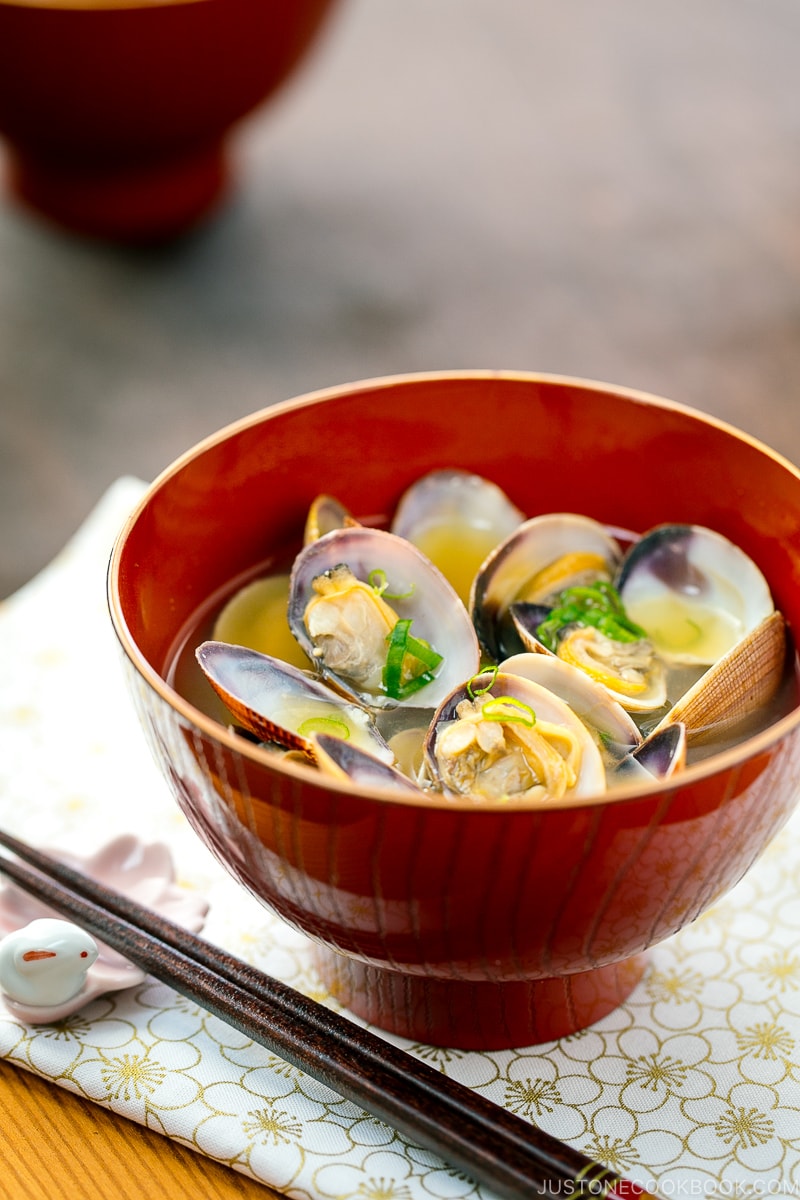
Did you know there are hundreds of varieties of Japanese miso soup? You’re probably familiar with tofu and wakame seaweed as the mainstream ingredients. Another popular choice in Japan is Japanese Clam Miso Soup (あさりの味噌汁), and it’s one of my favorites!
It’s typically made with asari or Manila clams, but you can use different kinds of clams for this recipe. Read on and I’ll show you how to prepare the fresh clams for this easy and delicate soup.
Table of Contents
What is Japanese Clam Miso Soup?
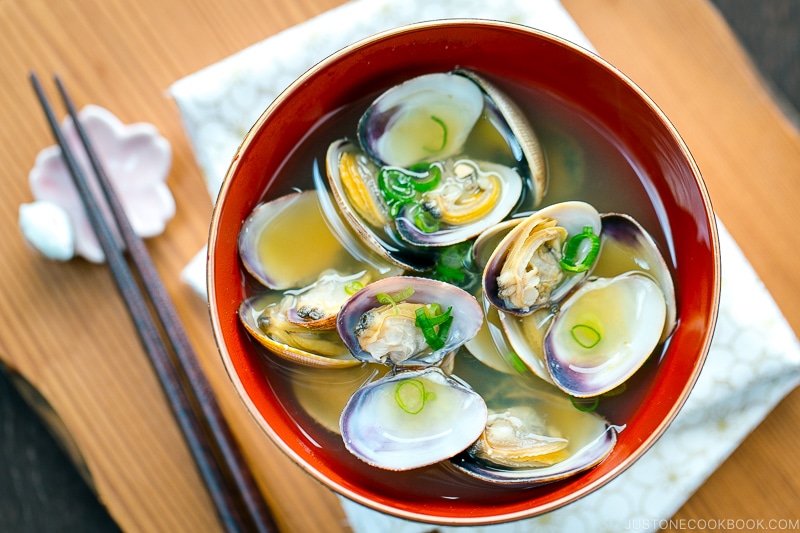
Japanese clam miso soup or asari no miso shiru (あさりの味噌汁) is a dish enjoyed in households and restaurants throughout Japan. As the name suggests, asari or Manila clam is the classic variety for traditional Japanese clam miso soup. You can use different types of clams in this recipe, too. Just be sure to use good quality, fresh clams.
It’s important to use clams as the only ingredient in the soup. That means no tofu or wakame seaweed. You do not want to mix the delicate clam taste with flavors from other ingredients.
Here, I use Kombu Dashi, a Japanese soup stock made from dried kelp. It has a light and clean umami flavor that pairs beautifully with the delicate clam stock. This is a departure from the standard Awase Dashi with katsuobushi (shaved bonito flakes) and kombu that I use for classic miso soup.
Why You’ll Love This Recipe
- flavorful and delicious
- so easy to make!
- a fancier version of the ordinary miso soup
- additional protein and nutrition

Ingredients You’ll Need
- Manila clams – called asari in Japanese; feel free to use other types of fresh, good-quality clams
- kombu (dried kelp)
- water
- miso (Japanese fermented soybean paste) – I use koji miso or awase miso, but you can use any type of miso you have
- scallions/green onions – chopped; for garnish to round out the dish beautifully.
If you prefer a clear broth without miso, try my Japanese clear clam soup called Ushiojiru.
Jump to RecipeHow to De-Grit and Clean Clams
It’s important to de-grit and clean the clams before cooking them. No one wants to taste or feel sand in their food.
You can find various articles on the Internet on how to de-grit clams, and they will probably work. In the US, popular methods include using cornmeal to get the sand out. Clams ingest the cornmeal, then purge out the sand and grit.
In Japan, however, fishermen and housewives all use saltwater; it’s how I de-grit and clean clams, too. If you are interested in the Japanese way, here’s a quick overview; see my tutorial on how to clean clams for detailed instructions and step-by-step photos.
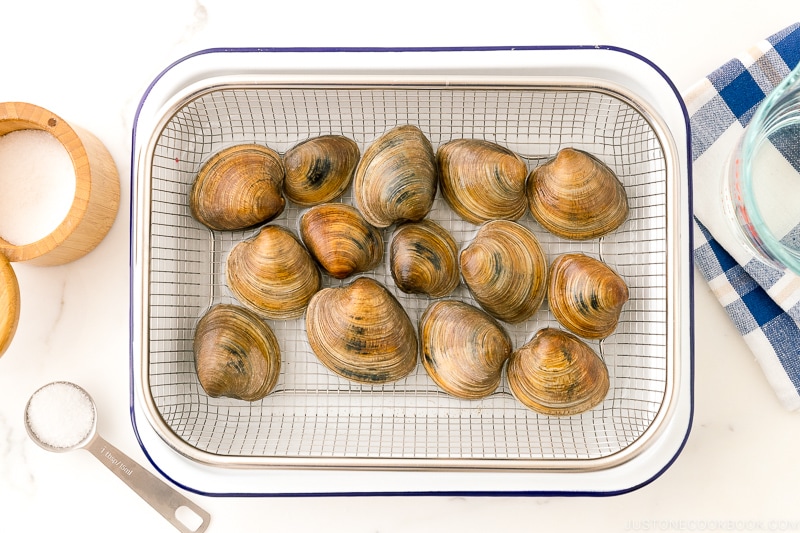
- Make the saltwater with cold water and a generous amount of salt. The salt concentration of seawater is about 3%, and you want to make your saltwater close to that.
- Tap the clams with open shells to make sure they close to check if they are alive. Then, place the clams in a wire rack or sieve set in a tray or pan so the purged sand falls to the bottom of the pan.
- Pour in the saltwater up to the level of the clams’s mouths. Do not fully submerge in the soaking water.
- Soak for 1 hour to let the clams purge their sand and grit.
- Scrub the clamshells with a brush under cold running water to clean them. Now, they’re ready to use!
How To Make Japanese Clam Miso Soup
- De-grit and clean the clams to purge them of sand using water and Diamond Crystal kosher salt. Start this process 1 hour before cooking.
- Add the clams, water, and kombu to a medium pot. Bring it to a boil over medium heat, then reduce to medium-low heat.
- Skim the scum and foam from the broth using a fine-mesh strainer.
- Turn off the heat immediately when all the clam shells open up. Do not overcook it.
- Dissolve the miso in a ladle filled with hot broth, then stir it into the soup.
- Serve in individual soup bowls. Sprinkle chopped green onions/scallions on top.
I hope you will give this easy miso clam soup a try! It’s a real treat to enjoy fresh clams this way.
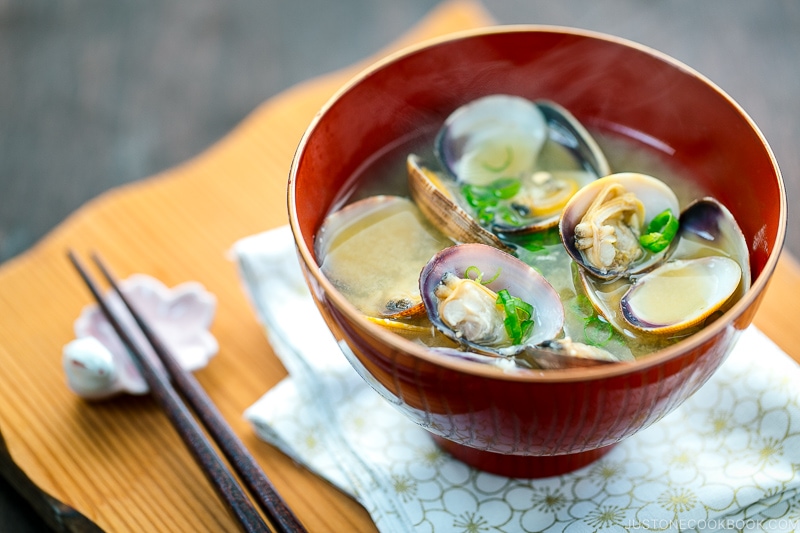
Other Soup Recipes You’ll Love
- Ushiojiru – Japanese clam soup with clear broth
- Sanpeijiru – Hokkaido-style salted salmon soup
- Harusame Soup – Japanese glass noodle soup
- Kenchinjiru – vegan Japanese vegetable soup with clear broth
- Miso Soup with Yuzu Kosho (Japanese citrus chili paste)
Wish to learn more about Japanese cooking? Sign up for our free newsletter to receive cooking tips & recipe updates! And stay in touch with me on Facebook, Pinterest, YouTube, and Instagram.
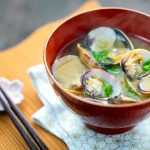
Japanese Clam Miso Soup
Ingredients
- ½ lb Manila clams (As soon as you purchase the clams, you must purge them of sand and clean them following my How to De-Grit the Clams tutoral. Start this process 1 hour prior to cooking.)
- 2 cups water
- 1 piece kombu (dried kelp) (0.2 oz, 5 g; 2 x 2 inches, 5 x 5 cm per piece)
- 2 Tbsp miso (I use koji miso or awase miso)
- 1 green onion/scallion (finely chopped)
Instructions
To Prepare the Clam Miso Soup
- In a medium pot, put the clean ½ lb Manila clams, 2 cups water, and 1 piece kombu (dried kelp) and bring it to a boil over medium heat.
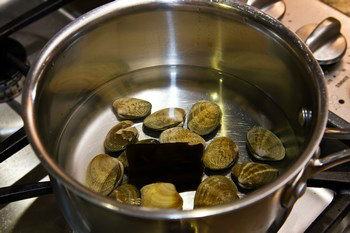
- Once boiling, reduce the heat to medium low.
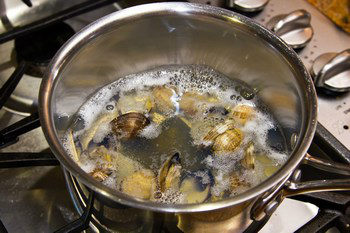
- Skim off the scum using a fine-mesh skimmer. Tip: Prepare a cup/bowl of water and dip the skimmer in the water to clean.

- When all the clams open up, turn off the heat immediately and do not overcook it. Remove and discard the kombu.
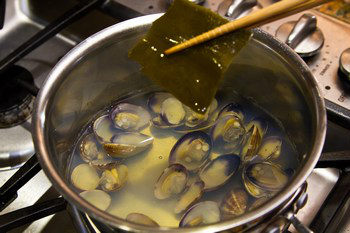
- Use a ladle and dissolve 2 Tbsp miso. Each brand of miso has different saltiness, so adjust the taste of the soup by adding more water or miso (add a small amount at a time).
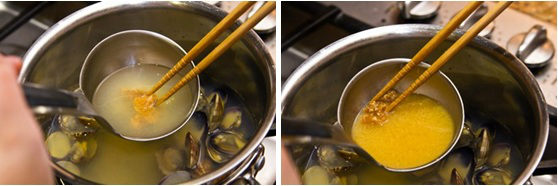
- Serve the Clam Miso Soup in individual soup bowls. Sprinkle with 1 green onion/scallion (chopped). When you need to reheat the soup, make sure you DO NOT BOIL the miso soup because it will lose its flavor.

To Store
- You can keep the leftovers in an airtight container or in the pot and store in the refrigerator for 24 hours.
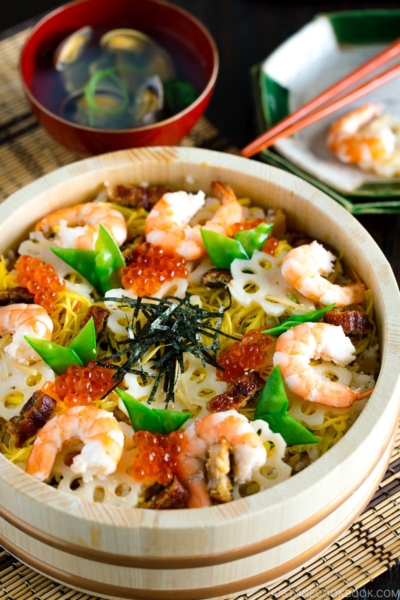

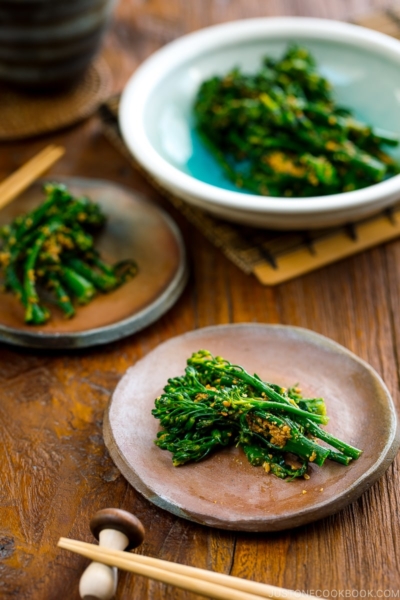
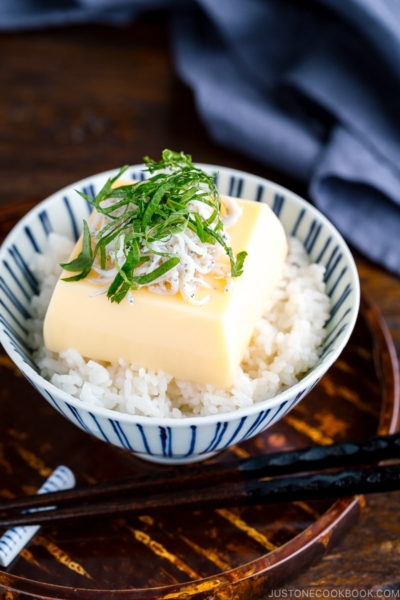




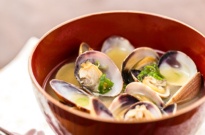
Thank you for this recipe, tastes like i remember from when i was little
Hello, Kayoko! Aww. We’re happy to hear that the recipes bring back memories of your childhood. 💞
Thank you for trying Nami’s recipe!
Can this broth be used for cold noodles? So using it as a broth for cold noodles
Hello, Netty. Thanks for reading Nami’s post.
Yes. If you like the taste of clams, you may incorporate them in another dish. It depends on your preferences. Enjoy!
Looking forward to trying this recipe. Skip the cornmeal when purging. Its a myth. Just use salt water and everything will be fine. If one gets fresh dug clams from a silty source, more than one purge may be necessary. Totally worth the effort, as fresh clams cannot be beat!
Hi James! Thank you for reading Nami’s post and trying her recipe!
We hope you enjoyed Clam Miso soup. Happy Cooking!
Sorry may I know what I can eat this with? Is this an entree or an appetizer? I’m wondering if this actually goes well with rice?
Hi Sarah! In Japan, we serve miso soup whenever we serve a bowl of steamed rice and a plate of pickles. We serve the main dish along 1-2 side dishes to make a proper meal. 🙂
Would canned clams possibly work in place of the fresh clams? They tend to be easier to get my hands on.
Hi Josh! Hmmm! That’s a tough question. I had never used canned clams….but I had used frozen one (and this one will work). Possible to get frozen clams? Only way to find out is to give it a try….. let us know if you try?
How would you use the frozen clams? I have some I got at Super H Mart and wondered if I still have to let them sit to remove the sand.
Hi Theresa! Thank you for trying Nami’s recipe.
The majority of frozen clams are ready to use. The sand should have already been removed. 🙂
We hope this helps!
I’m anxious to try this because I had the most delicious clam miso soup at a restaurant in Costa Mesa, CA called Murasaki. Hope to duplicate that!
Hi Frances! I hope you enjoy the recipe! 🙂
Made this tonight with ginger rice and a fantastic Indonesian salmon. The miso was exquisite and love by my family.
Hi Bob! I’m so happy to hear you enjoyed this recipe! Thank you for trying and for your kind feedback. 🙂
Another fabulous dish! We added bonito flakes to the kombu and used mussels rather than clams, but it was delicious! The mussels made the broth sweet and so flavorful! Thanks!
Yay! Thank you for trying this recipe! I’m really happy to hear mussels worked too! Thank you for writing your kind feedback. xo
Can you use the instant dashi powder instead as substitute?
Hi Vivian! Sure you can do that. 🙂
Should the clams be submerged in the salt water? If so, won’t the grit make their way back into the clams?
If they’re not submerged, how does the grit get removed?
Hi Sylvia! What I mean is that you don’t pour salt water that completely covers (like under water). I’m not sure about how other countries do this, but in Japan, we recreate the similar environment as ocean so we put just enough water to cover some parts of the shell, not entirely sunk under water. By creating the “comfortable” environment, the clams get relax and purge the grit. Which is why we also keep the clams in dark area. It might sound funny but that’s the common practice to de-grit.
To avoid the grit coming back to the clams, we use a sieve or something to raise the clams above the bottom of the bowl. So grit falls down to the bottom of bowl.
I also explained in here – similar setting:
https://www.justonecookbook.com/how_to/how-to-degrit-clams/
Thank you Nami! I followed your directions exactly, from the degritting all the way to the end, and it was the best clam miso shiru I’ve ever had.
Hi Sylvia! Yay! I’m so happy to hear that. One of readers also told me she was surprised how much her clams purge the grit following my recipe. I think there is a different way to degrit here in the US, but Japanese method works for me every time. 🙂
I made this tonight. My husband loved it! Good thing I made a double recipe! I have cooked with fresh clams before, but NEVER did the recipe include instructions for degritting. I was amazed at the stuff that came out – and grossed out that I hadn’t done this in other recipes, like clam chowder. But I will from now on! I have learned many helpful things from you, Nami, and I appreciate it.
Hi Debbie! I’m so happy your husband enjoyed it. 🙂 The “degretting” method is pretty common in Japan but I was also surprised that American recipes don’t quite explain the degretting process in the recipes. I’m glad you got the stuff out before cooking! 😀
Thank you for all these recipes takes me back to home
Hi Ruriko! My pleasure. 🙂
Hi. I only have the powder dashi kombu instead of the seaweed. how many tsp should i use? thanks!
For this much water, 1 tsp should be enough. Some people don’t use kombu and use the flavor only from the clams. 🙂 Hope you enjoy!
Hi great website and blog. Tried out your clam in miso soup recipe and it worked beautifully and easily too. My wife was pleased so I m in her good books. Marinating a few fillets of dorade bream in miso (followed your bass in miso recipe) and firing up the grill tomorrow or the day after. Your recipe is fairly close to Nobu’s recipe but his has a lot of sugar. Will it make any difference? Also I am using a taiwanese miso instead of japanese as it comes in smaller packs and cheaper too. I won’t be able to finish the standard packs of miso from japan.
Hi enjoyla! Thank you for your kind words. I’m so happy you tried out this recipe and enjoyed it! Hope the fish was good too. The traditional miso cod recipe requires only three ingredients: miso, sake, and mirin. Sugar is not necessary because mirin will add sweet soft flavor just enough to bring out the sweetness. I’ve never seen a Taiwanese miso before (didn’t know that exist!). Well, as you know, miso plays a big role in this dish since that’s the main ingredient. If you use very good miso, the result is amazing (regular miso works too). One day I hope you can try it out with Saikyo miso – the original miso for this recipe. 🙂
Thank you again for writing! 🙂